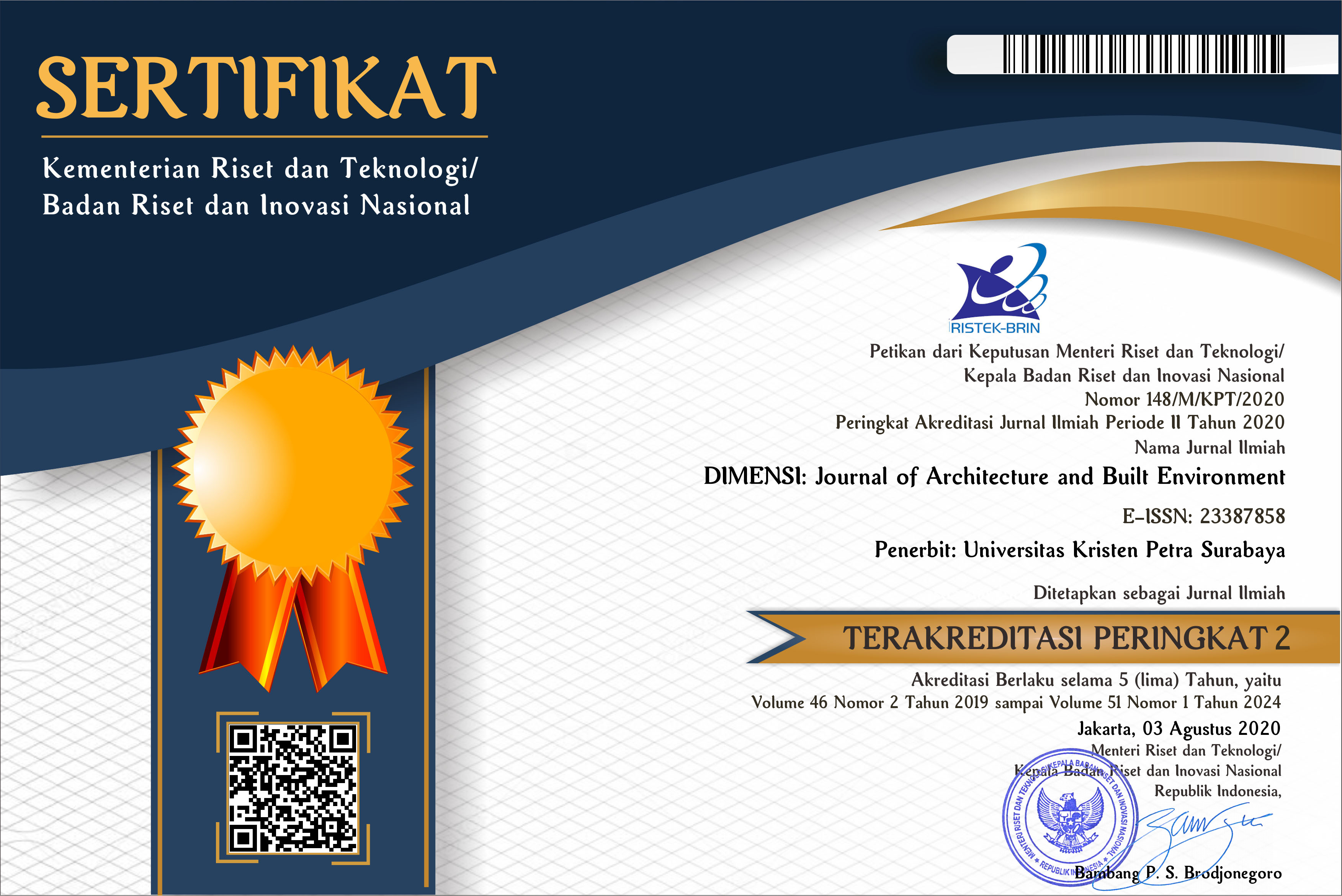UNDERSTANDING RESIDENT’ ACTIVITY SYSTEM-IMPROVING QUALITY LIFE: A CASE STUDY OF DOME POST DISASTER SETTLEMENT IN NGELEPEN SLEMAN, YOGYAKARTA
 :
:
https://doi.org/10.9744/dimensi.43.2.137-142
Keywords:
Post-disaster dome settlement, activity system, social interaction.Abstract
House is not only functioning as a place for shelter, but also for accommodating personal and social activities of its inhabitants. Unfortunately in post quake disaster dome houses Ngelepen, Yogyakarta, the majority of the early settlers must change their behavior and habits that they used to do in their previous environment to adjust the new settlement. These happened because dome housing did not facilitate some activities whether personal or social activities within the house, therefore the activities extended to the outside of the house or even the surrounding environment. This study aims to understand the system activities on the dome house settlement Yogyakarta. In order to get detailed description, quantitative as well as qualitative approach was done through observation of the activities type, when and where the activities conducted. Data collection was done by continuous place centered behavior mapping to know how the occupants use and accommodate their behavior in certain time and specific place. The results of this study showed that daily activities on weekdays and holidays conducted by different group; children, adult and elderly, at different areas and for different type of activities in certain times. The pathways and courtyard of the house mostly used for domestic household activities and leisure as an extension of the social interaction space. In understanding the system activities that occurred, it is expected that this study can contribute to improve the quality of life of people live in a relocation settlement.
Downloads
References
Asmal et al. (2015). Coastal Environmental Degradation U.S. Communal Space, Impact on Social Fishermen Community Life at North Galesong. Journal of innovation and research in Educational Sciences, 2(5). ISSN (online): 2349-5219. [CrossRef]
Darmiwati, R. (2000). The study together in the space of housing for low-income residents. Journal Dimension, 28(2), p.114-122. [CrossRef]
Hamilton-Baillie, B. (2008). The Shared Space: Reconciling People, Place and Traffic. Journal of the Built Environment, 34(2), p.161-181. [CrossRef]
Indeswari, A. et. al. (2013). The pattern with the space on the settlement of the Madurese Medalunganin Hamlet Baran Randugading. Journal of the section, 11(1), p.37-46. ISSN 1693-3702. [CrossRef]
Lang, J. (1987). Creating Architectural Theory. New York: Van Nostrand Reinhold Company. [CrossRef]
Marcillia, S.R. & Ohno, R. (2012). Amounts of Social Space in Self-Built and Donated Post Disaster Housing After Java Earthquake 2006. Asian Journal of Environment-Behavior Studies, 3(7), p. 25-34. [CrossRef]
Oliver, P. (1987). Dwellings: The House across the world. Austin: University of Texas Press. [CrossRef]
Purwanto, E. et. Al. (2012). The pattern of communal space in the Home Row Bandarharjo Semarang. Journal DIMENSI, 39(1), p.23-30. ISSN 0126-219X. [CrossRef]
Rusyidi, M. (2008). The behavior of the Companions of the house of the Dome in Prambanan, Sleman: Adaptation and Adjustment in the new settings. Journal of cross-space, 2(3), p.99-108. ISSN 1978-0702. [CrossRef]
Rapoport, A. (1969). House, Form and Culture. Englewood Cliffs NJ: Prentice-Hall. [CrossRef]
Rapoport, A. (1983). Culture and Change and Supportive Design. Pergamon Press: New York. [CrossRef]
Saraswati, T. (2007). House Dome in Nglepen controversy, Prambanan, D.I. Yogyakarta. Journal DIMENSI, 32(2), p.136-142. [CrossRef]
Zeisel, J. (1985). Inquiry by Design: Tools for Environment-Behavior Research. Cambridge, UK: Cambridge University Press.[CrossRef]
Downloads
Published
How to Cite
Issue
Section
License
Authors who publish with this journal agree to the following terms:
- Authors retain copyright and grant the journal right of first publication with the work simultaneously licensed under a Creative Commons Attribution License that allows others to share the work with an acknowledgement of the work's authorship and initial publication in this journal.
- Authors are able to enter into separate, additional contractual arrangements for the non-exclusive distribution of the journal's published version of the work (e.g., post it to an institutional repository or publish it in a book), with an acknowledgement of its initial publication in this journal.
- Authors are permitted and encouraged to post their work online (e.g., in institutional repositories or on their website) prior to and during the submission process, as it can lead to productive exchanges, as well as earlier and greater citation of published work (See The Effect of Open Access).


















